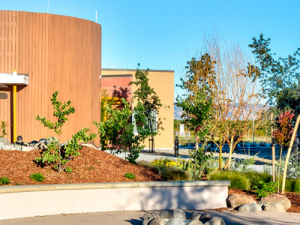Climate stressors and impacts
Because large portions of Orleans Parish are already below sea level, New Orleans is particularly vulnerable to rising sea levels caused by climate change. Scientists expect sea levels to continue rising in the next decades: climate change melts glaciers and warms the ocean, and water expands as it warms.
Hurricane Katrina demonstrated the dangers that flooding presents to New Orleans when its storm surge overwhelmed the levees built to protect the city. Among the many buildings catastrophically damaged by the flooding were the city’s Veterans Administration Medical Center and Charity Hospital. Patients had to be evacuated to a temporary clinic, and floodwaters severely damaged the buildings.
Turning the hospital "upside down"
Rather than repair the existing structures, the Veterans Administration designed and built a new, more resilient teaching hospital in an adjacent neighborhood. With climate change increasing the likelihood of significant flooding in New Orleans, designers had to figure out how the new hospital will be able to continue providing service even if the levees fail again. Their solution was to ensure that flooding would not reach the center’s critical
The new facility has been decribed as an ‘upside-down hospital’ because the electrical and plumbing systems are located at the top of the building. This innovative design helps enusre that the hospital can remain operational even in the midst of a flood,”
The new replacement facility incorporated a comprehensive set of resilience strategies designed specifically to deal with the risks facing post-Katrina New Orleans. All mission-critical mechanical and electrical infrastructure components of the facility are now housed in the upper levels, away from potential flood waters. Required program components, such as the emergency department and patient beds, are at least 20 feet above the established FEMA Base Flood Elevation (or BFE, the phrase for the elevation that flood waters would reach during a flood so severe it has only a one percent chance of occurring each year). The kitchen is located on the fourth floor, while the cafeteria will be on the ground floor—a dedicated elevator will transport food from the kitchen to the cafeteria during normal building operation. Ambulances use a dedicated ramp to reach the facility, and this ramp can double as a boat launch; the parking structure roof serves as a heliport and is able to support Black Hawk helicopters in an evacuation.
Staying afloat during a disaster
The new hospital’s more resilient infrastructure gives it seven-day “defend in place” capability. The facility’s energy plant can store 320,000 gallons of fuel, enough to operate for a full week, so the facility can remain fully operational without outside power during a disaster. Additionally, a 6,000-square-foot on-site warehouse stores emergency supplies stocked with provisions to support 1,000 staff and patients for 5 days. The building’s enclosure and windows are designed to survive at least Category 3 hurricane winds, and staff and visitors will be able to travel from building to building entirely indoors at elevations that would not be affected by flood waters.
The center’s designers also wanted to take advantage of available natural resources to make the facility more efficient and resilient. Thus, the facility can collect and store over a million gallons of rainwater on-site, allowing it to use less city water for cooling systems and other uses during normal operation. This stored rainwater can also provide needed water if the city supply is disrupted or unavailable. The center also contains an on-site sewage treatment system capable of processing and holding waste for five to seven days.



